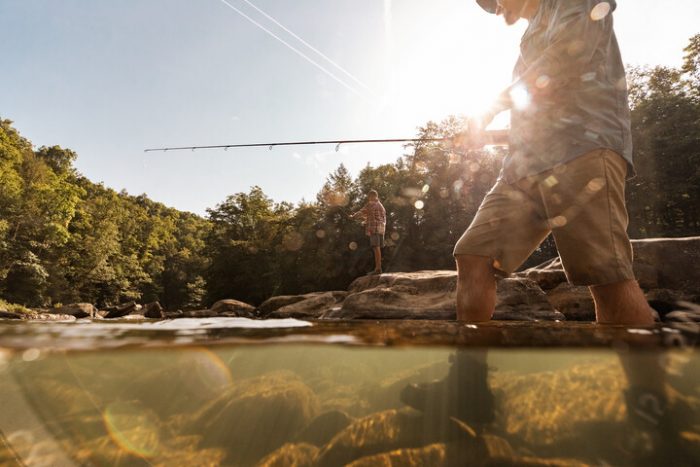Freshwater mussels are aquatic filter feeding animals that are not unlike marine clams in appearance. Mussels are mollusks with a body covered by a hinged shell that protects the mussel throughout its life.
Freshwater Mussels in West Virginia
Adult mussels range from 2 inches (salamander mussel) to 1 foot (washboard mussel) in length. Mussel shells are varied between species being: smooth or rough, dull or brightly colored, oval or pointed in shape and every combination between. Freshwater mussels can be extremely long lived with some species known to regularly reach 80 years old. Eastern North America is home to the highest diversity of mussels on earth, boasting approximately 300 species. West Virginia is home to 65 of these species. They are found from the Ohio River, all the way up in small headwater streams and some species can be found residing in our reservoirs.
History of Mussels in West Virginia
Mussels have been used by humans since ancient times; native peoples used the shells in tools and for ordainments. It is also believed that freshwater mussels may have provided an additional source of food when necessary. Mussel numbers remained high in West Virginia water leading to the button industry rise in the late 1800’s and early 1900’s. Mussels were collected for their shells and had buttons cut out of them. You can observe that many modern plastic buttons try to imitate the look of mussel shells. Around the same time as the button industry rise, many of our larger rivers were levied and dammed to provide passage for commerce and barge traffic. The latter half of the 20th century introduced the cultured pearl industry utilizing the shells of freshwater mussels as starter pearls. These combined activities drove populations down to a point that the possession of mussels was banned throughout the state to help protect the entire group of animals.
Life Cycle and Natural History
Freshwater mussels feed by filtering the water, collecting organic matter and algae from the water column. This form of feeding has the benefit of improving the water quality for other aquatic organisms. They also provide sediment stability and food for other benthic invertebrates as well as being the prey of fish and many small river mammals (muskrats, raccoons, river otters etc.). Being unable to swim, most mussels spend almost all of their lives in a single spot in the river, only burying and unburying themselves at the change of the seasons. This relative immobility has led to the evolution of varied and complex reproduction cycles involving a fish host. Without the ability to “find” a mate, males release gametes directly into the water column which are filtered out by females to be fertilized. These fertilized females then develop thousands of larvae called glochidia, which are held in their gills. After fertilized, mussel species take differing strategies to get the glochidia onto a specific fish host. Some mussels produce a “packet” of glochidia that may resemble a larval insect or worm which is released into the water column for an unsuspecting fish to eat and become inoculated. Other species take a more active role by luring the fish between the two halves of its shell by flapping intricate shaped appendages that often resemble small fish. Once a fish has been lured in, the mussel clamps down on the fish and releases the glochidia which attach to the gills and fins. While unpleasant, fish mortality is uncommon from such encounters. Once a fish is inoculated, the glochidia will mature over 2-10 weeks, at which point they will drop off the fish, hopefully landing on a suitable area of stream bottom to live out the remainder of their lives.
Current Threats
Populations have continued to decline across the state over the past century. Disruptions in water quality along with increased sedimentation from human activities have caused reduced reproductive success, mortality and buried mussel beds. The invasive zebra mussel (Dreissena polymorpha) continues to cause mortality by attaching themselves to the exterior surfaces of native mussels, reducing their ability to filter feed and to move up and down in the substrate. Disconnection to host fish and reduced reproductive success has caused several species to have age distributions that are increasingly elderly, with fewer young mussels to replace them. These disruptions have led 10 mussel species to become federally listed threatened or endangered within the state.
Future of Mussels in West Virginia
The West Virginia Division of Natural Resources aims to conserve and protect all mussels in an effort to promote recovery of the animals throughout the state. The WVDNR maintains a list of mussel streams in the state that require a mussel review prior to in-stream activities. A detailed mussel protocol and mussel conservation guidance document can be found on the website. The state currently works with our federal partners out of White Sulfur Springs National Fish Hatchery to propagate and stock mussels throughout the state in an effort to reestablish and bolster mussel populations. In the coming years the WVDNR plans to build its own mussel hatchery to increase mussel stocking efforts throughout the state. For information relating to mussels, best management practices, and in-stream work requirements for mussel streams please contact the WVDNR Elkins Operations Center.
Helpful Resources
- WV Mussel Stream Layer
- 2022 WV Mussel Protocol
- 2022 Mussel Stream Guidance
- 2022 Protocol Comment Response
- Certified Mussel Surveyors 5_2022
- Letter to Approved Surveyors 2022
- WV Mussel List 2021
- Current Stream and Weather Conditions
- DNR Summary Data Sheet
- Project Information
- Violation Ranking 2018
- The Freshwater Mussels of West Virginia



